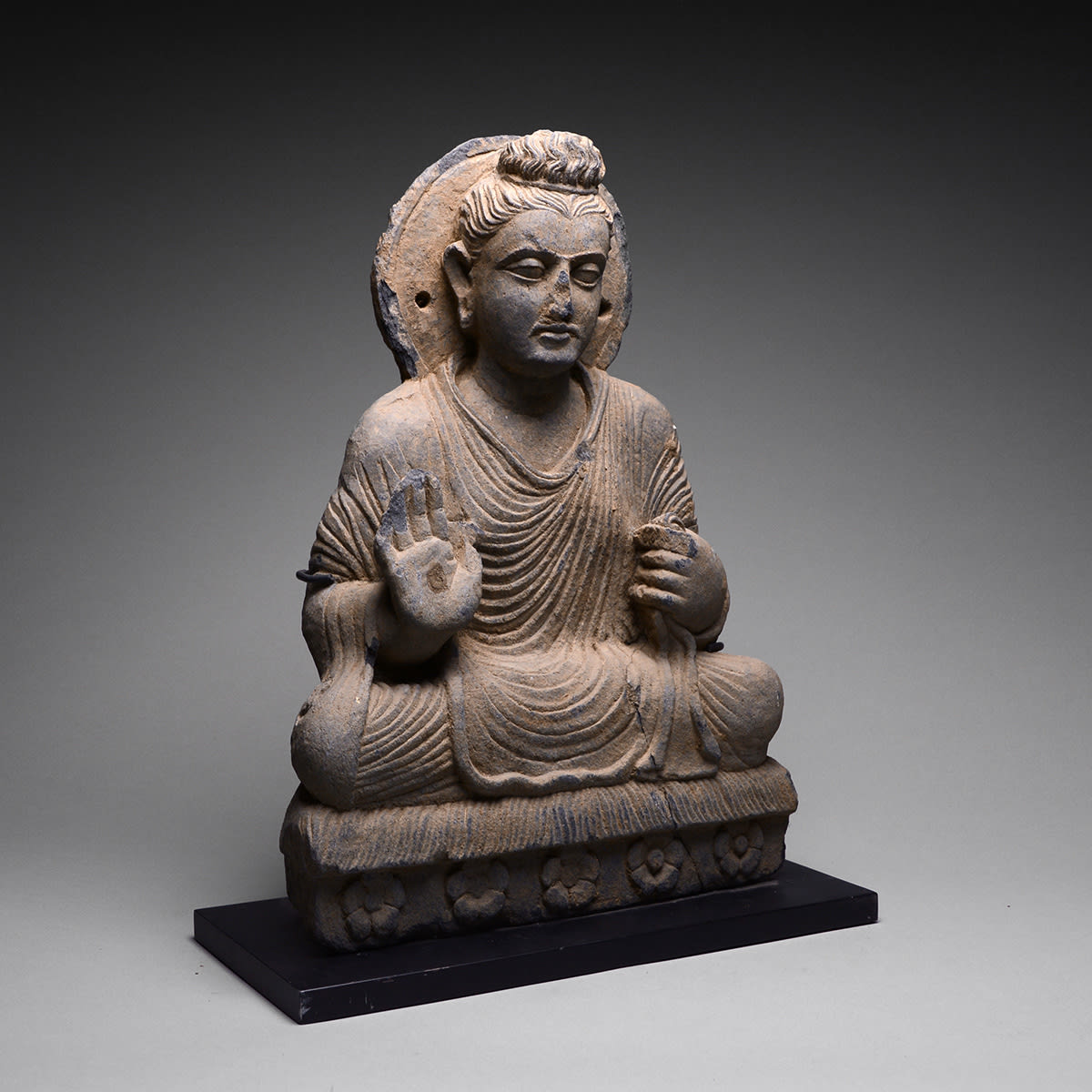Gandhara Schist Sculpture of the Seated Buddha, 200 CE - 500 CE
Schist
height 45.7 cm
height 18 in
height 18 in
PF.4359 (LSO)
Further images
This beautiful sculpture was made in the ancient kingdom of Majajanapada, better known as Gandhara. Situated on the border between what is now Pakistan and Afghanistan, the kingdom contained several...
This beautiful sculpture was made in the ancient kingdom of Majajanapada, better known as Gandhara. Situated on the border between what is now Pakistan and Afghanistan, the kingdom contained several notable cities that flourished between the 6th century BC and the 11th century AD. It saw enormous changes with the ebb and flow of contemporary superpowers. It also became a centre of learning (notably with the invention of the Kharosti alphabet) and of religious pilgrimage, as this is where the holy scriptures of Buddha were kept. Prior to this in the 6th century BC Gandhara was absorbed into the Achaemenid (Persian) Empire. The collapse of this dynasty led to a series of power struggles that ended with the crushing of native armies by Alexander the Great in 327 BC. This was followed by the attack by Demetrius of Bactria, and while the area was Graeco-Bactrian for some time, it eventually gained independence under King Menander in the mid 2nd century BC. The final effects of Greek colonialism were eroded by about 50 BC under a fierce campaign headed by the Parthians. While catastrophic to social order at the time, the cultural diversity of the region was greatly enhanced by the appearance of the Greeks, especially in terms of artistic production. Even after the Greeks had gone, their bequest remained in the aesthetic sense that makes Gandharan art unique.
The golden period of Gandharan art dates to c. 100-200 AD with the arrival of the Kushans, a Central Asian group under whose governorship the arts and sciences flourished as never before. The cocktail of different cultures saw a completely unique set of architectural and artistic traditions. Their greatest monarch, Kanishka, encouraged the arts, and under his reign totally new conventions were to develop including the earliest depictions of the Buddha in human form. The cultural syncretism between eastern themes and western styles has become known as Graeco-Buddhism, and is one of the most remarkable – and successful – examples of cultural fusion in history. Everything from architecture to sculpture, coinage and even jewellery developed in new and extraordinary ways. Myths and figures from Greek mythology – such as Atlas, or Dionysus – are also found in some friezes and paintings. The Buddhas resemble Greek kings in ersatz togas, sitting in houses influenced by the Corinthian model, while Bodhisattvas and other religious figures are often depicted with startling realism as bare-chested Indian princes.
The current sculpture is a case in fact. The startling realism of the facial features accentuates the calm expression, with heavily lidded eyes, linear brows and slightly pursed lips. This is combined with flawless rendering of the simple draperies. Unlike the minor deities, he is unadorned except for his elongated earlobes. The elevated hairstyle – superbly carved into a tied topknot pattern – conceals the ushnisha, the extra brain of elevated consciousness that achieves more exaggerated expression in later sculptures from across Southern Asia. The hand gestures – which are highly formalised in most branches of Buddhism – imply that the Buddha is expressing the “mudra” known as the Absence of Fear (Abhâya mudrâ). He is sitting on a simple cushion atop a low plinth that is carved with five lotus flowers. This is a mature and beautifully executed work of ancient art.
The golden period of Gandharan art dates to c. 100-200 AD with the arrival of the Kushans, a Central Asian group under whose governorship the arts and sciences flourished as never before. The cocktail of different cultures saw a completely unique set of architectural and artistic traditions. Their greatest monarch, Kanishka, encouraged the arts, and under his reign totally new conventions were to develop including the earliest depictions of the Buddha in human form. The cultural syncretism between eastern themes and western styles has become known as Graeco-Buddhism, and is one of the most remarkable – and successful – examples of cultural fusion in history. Everything from architecture to sculpture, coinage and even jewellery developed in new and extraordinary ways. Myths and figures from Greek mythology – such as Atlas, or Dionysus – are also found in some friezes and paintings. The Buddhas resemble Greek kings in ersatz togas, sitting in houses influenced by the Corinthian model, while Bodhisattvas and other religious figures are often depicted with startling realism as bare-chested Indian princes.
The current sculpture is a case in fact. The startling realism of the facial features accentuates the calm expression, with heavily lidded eyes, linear brows and slightly pursed lips. This is combined with flawless rendering of the simple draperies. Unlike the minor deities, he is unadorned except for his elongated earlobes. The elevated hairstyle – superbly carved into a tied topknot pattern – conceals the ushnisha, the extra brain of elevated consciousness that achieves more exaggerated expression in later sculptures from across Southern Asia. The hand gestures – which are highly formalised in most branches of Buddhism – imply that the Buddha is expressing the “mudra” known as the Absence of Fear (Abhâya mudrâ). He is sitting on a simple cushion atop a low plinth that is carved with five lotus flowers. This is a mature and beautifully executed work of ancient art.
Literature
V22







